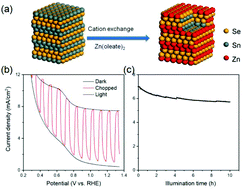Near-infrared heavy-metal-free SnSe/ZnSe quantum dots for efficient photoelectrochemical hydrogen generation†
Abstract
Solar-driven photoelectrochemical (PEC) hydrogen production is one of the most effective strategies for solar-to-hydrogen energy conversion. Among various types of semiconductors used for PEC anodes, colloidal quantum dots (QDs) have been widely used as new and promising absorbers for PEC and other optoelectronic devices. However, currently, most efficient optoelectronic devices contain toxic Pb/Cd elements or non-earth-abundant elements (In/Ag). It is still a challenge to produce Pb/Cd-free QDs without using any toxic and non-earth-abundant elements. Here, we synthesized SnSe QDs via a diffusion-controlled hot injection approach and further stabilized the as-prepared SnSe QDs via a cation exchange reaction. The as-synthesized Zn-stabilized SnSe QDs (SnSe/ZnSe) have an orthorhombic crystal structure with indirect bandgaps ranging from 1 to 1.37 eV. Zn stabilization can significantly decrease the number of QD surface metallic Sn bonds, thereby decreasing the number of recombination centers of defects/traps. As a proof-of-concept, SnSe/ZnSe QDs are used as light absorbers for PEC hydrogen production, leading to a saturated photocurrent density of 7 mA cm−2, which is comparable to best values reported for PEC devices based on toxic-metal-free QDs. Our results indicate that Zn-stabilized SnSe QDs have great potential for use in emerging optoelectronic devices.



 Please wait while we load your content...
Please wait while we load your content...